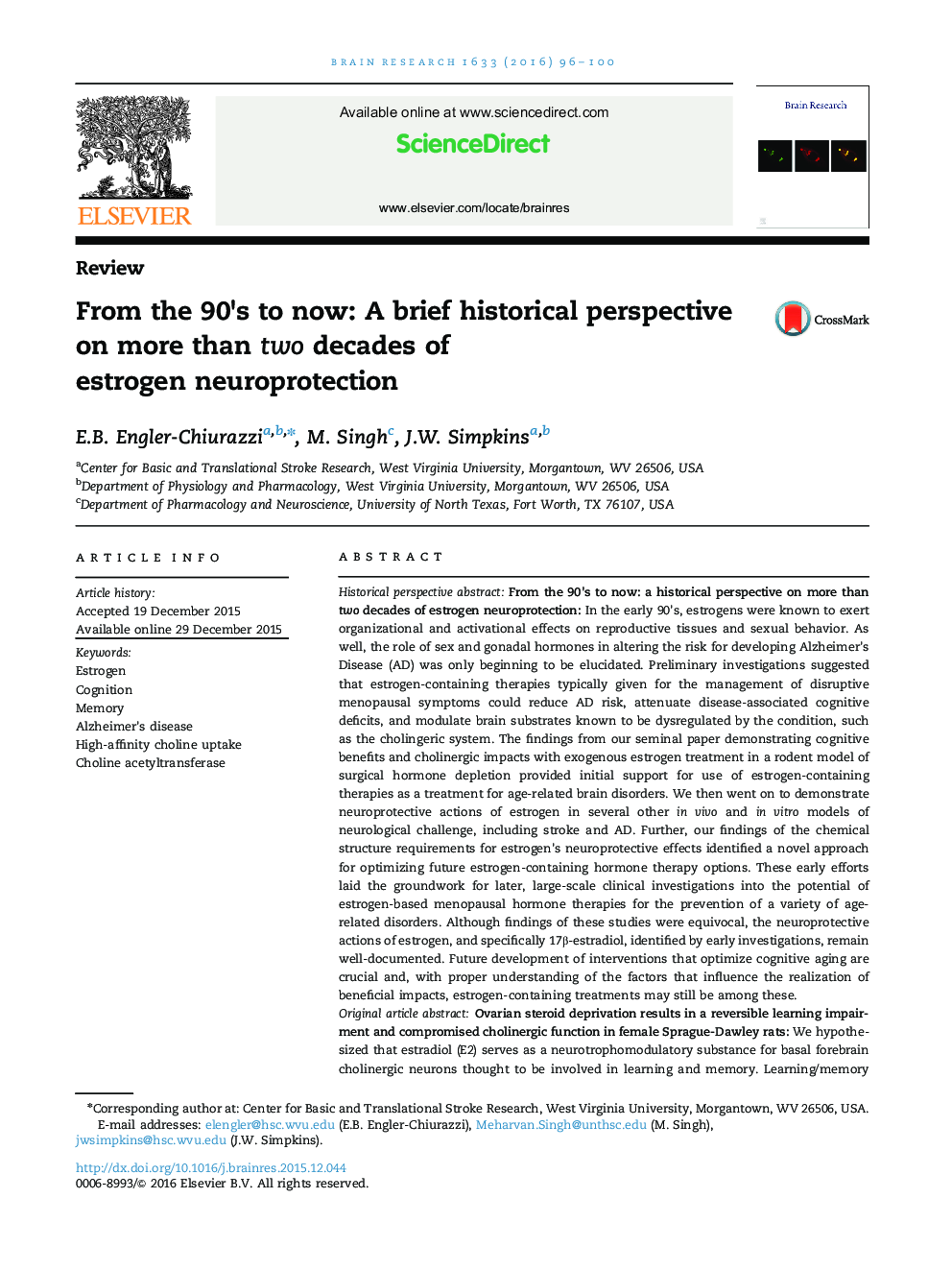| کد مقاله | کد نشریه | سال انتشار | مقاله انگلیسی | نسخه تمام متن |
|---|---|---|---|---|
| 4323717 | 1613807 | 2016 | 5 صفحه PDF | دانلود رایگان |
Historical perspective abstract:From the 90׳s to now: a historical perspective on more than two decades of estrogen neuroprotection: In the early 90׳s, estrogens were known to exert organizational and activational effects on reproductive tissues and sexual behavior. As well, the role of sex and gonadal hormones in altering the risk for developing Alzheimer׳s Disease (AD) was only beginning to be elucidated. Preliminary investigations suggested that estrogen-containing therapies typically given for the management of disruptive menopausal symptoms could reduce AD risk, attenuate disease-associated cognitive deficits, and modulate brain substrates known to be dysregulated by the condition, such as the cholingeric system. The findings from our seminal paper demonstrating cognitive benefits and cholinergic impacts with exogenous estrogen treatment in a rodent model of surgical hormone depletion provided initial support for use of estrogen-containing therapies as a treatment for age-related brain disorders. We then went on to demonstrate neuroprotective actions of estrogen in several other in vivo and in vitro models of neurological challenge, including stroke and AD. Further, our findings of the chemical structure requirements for estrogen׳s neuroprotective effects identified a novel approach for optimizing future estrogen-containing hormone therapy options. These early efforts laid the groundwork for later, large-scale clinical investigations into the potential of estrogen-based menopausal hormone therapies for the prevention of a variety of age-related disorders. Although findings of these studies were equivocal, the neuroprotective actions of estrogen, and specifically 17β-estradiol, identified by early investigations, remain well-documented. Future development of interventions that optimize cognitive aging are crucial and, with proper understanding of the factors that influence the realization of beneficial impacts, estrogen-containing treatments may still be among these.Original article abstractOvarian steroid deprivation results in a reversible learning impairment and compromised cholinergic function in female Sprague-Dawley rats: We hypothesized that estradiol (E2) serves as a neurotrophomodulatory substance for basal forebrain cholinergic neurons thought to be involved in learning and memory. Learning/memory was assessed using the two-way active avoidance paradigm and the Morris water task. Female Sprague-Dawley rats were either ovariectomized (OVX) or OVX for 3 weeks, followed by s.c. implantation of a Silastic pellet containing 17-βE2 (E2 pellet), resulting in a replacement of E2 to physiological levels. Ovary-intact (INTACT) animals served as our positive control. Active avoidance behavior and choline acetyltransferase (ChAT) activity in the frontal cortex and hippocampus were assessed at 5 and 28 weeks postovariectomy while performance on the Morris water task and high-affinity choline uptake (HACU) were measured only at the 5-week time point. At the 5-week time point, E2 replacement caused a significant elevation in the level of active avoidance performance relative to OVX animals. At the 28-week time point, OVX animals demonstrated a significantly lower number of avoidances relative to controls (61%) whereas E2-pellet animals not only demonstrated superior performance relative to OVX animals but also showed an accelerated rate of learning. Morris water task performance, on the other hand, was not significantly affected by estrogenic milieu despite a trend towards better performance in the E2-pellet group. Neurochemical analyses revealed that 5 weeks of ovariectomy was sufficient to reduce HACU in both the frontal cortex and hippocampus by 24 and 34%, respectively, while E2 replacement was successful in elevating HACU relative to OVX animals in both regions. ChAT activity was decreased in the hippocampus but not the frontal cortex of 5-week OVX animals. E2 replacement resulted in a reversal of this effect. At the 28-week time period, an unexpected decrease in ChAT activity was observed across all treatment groups. Interestingly, E2-pellet animals demonstrated the least severe decline in ChAT. This phenomenon was most evident in the frontal cortex where ChAT decreased by 61 and 56% in INTACT and OVX animals, respectively, whereas the decline in E2-pellet animals was only 16% over the same time period, suggesting a previously unreported cytoprotective effect of E2. Taken together, these findings demonstrate important effects of estrogens on cholinergic neurons and support the potential use of estrogen therapy in treatment of dementias in postmenopausal women. © 1994.This article is part of a Special Issue entitled SI:50th Anniversary Issue.
Journal: Brain Research - Volume 1633, 15 February 2016, Pages 96–100
